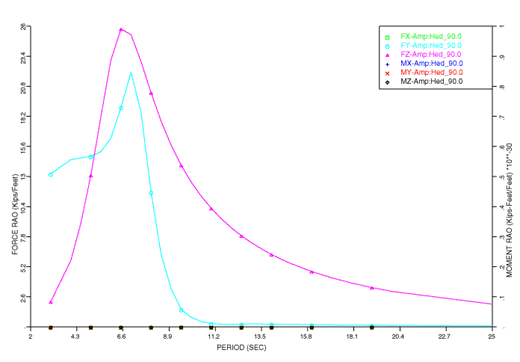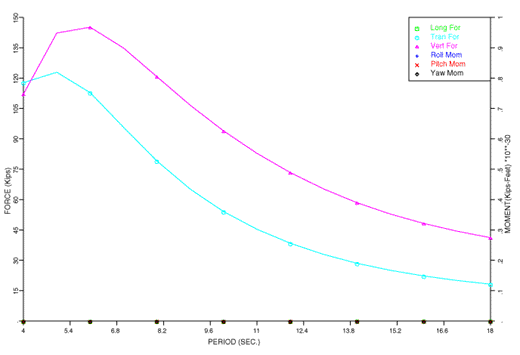Overview Of Seakeeping:
By seakeeping, we mean finding the motions and related quantities of a vessel subjected to a sea state. Normally, this is further restricted to mean that the motions are computed in the frequency domain. While we can compute the motions in other ways, here we will consider only the frequency domain. Now, in order to compute the motions, one must compute the forces. This is accomplished by using either Morison's' equation, two dimensional diffraction theory, or three dimensional diffraction theory. While the mathematics of these three theories differ, the important thing here is that they all compute the excitation force, the added mass, and the radiation damping for a vessel as a function of frequency and heading. When the equations of motions are solved for a unit amplitude wave, we obtain a set of quantities called Response Amplitude Operators, or RAOs. Here is a typical set of RAOs for a barge.
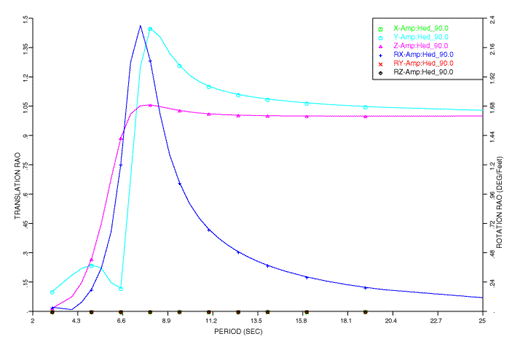
For semisubmersibles (and other similar vessels) the radiation damping is small for all degrees of freedom at the natural frequencies. Thus, for these shapes, viscous damping needs to be added in all degrees of freedom, not only roll. An RAO curve for a semi corresponding to the above is:
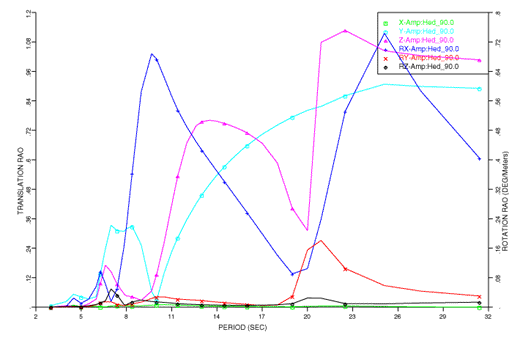
w = sqrt ( K/M )
The problem is that here M includes the added mass which depends
on frequency. Thus, which M do we use to compute the natural
frequency? Now, different people address this difficulty differently.
We prefer to say that here there is no such thing as a natural
frequency - only frequencies at which the response is larger than
others. In addition to having M vary with frequency, the excitation
force also varies. Thus, it is not surprising to get several
relative maxima. The periods at which the maxima occur depend on
the hull form (which defines the excitation, the added mass,
and a part of the spring constant K) and the mass distribution
(which determines the basic inertia and a contribution to K).
For a given ship at a given draft and trim, we can change the
RAOs quite a bit by moving mass around.
One important thing to remember is that since we added viscous damping, the problem became nonlinear. Now, the results can not, strictly speaking, be "scaled up" from unit amplitude to realistic values. What is "allowable" mathematically depends precisely on how we linearized the problem. There are two approaches one can use. First, one can use a constant steepness to linearize the system. Here the wave height used to compute the response is obtained from the frequency and the wave slope. The second approach is to spectrally linearize the system by computing the amplitude of a wave at each frequency that would follow from a specified spectrum. Both approaches seem to work fairly well and allow us to use the "RAOs" as if they were linear, provided they are used with spectra which are close to either the spectrum used to linearize the system, or have a mean steepness reasonably close to that used.
Now, the RAOs themselves are of limited use because we rarely encounter a "regular sea" (a sea composed of waves which look like sine waves). In reality, the sea is "confused" with peaks and valleys all over the place. Thus, a sea is normally specified by a spectrum - a function of frequency and heading which gives a measure of the square of the amplitude of a sine wave of this frequency and heading in the sea. With a spectrum and the RAOs, one can compute the "moments" of the response spectrum, but what does one do with moments of the response spectrum? Normally, one assumes a probability distribution (Raleigh is normally chosen) and uses it and the moments to compute probabilities of exceedence. The following:
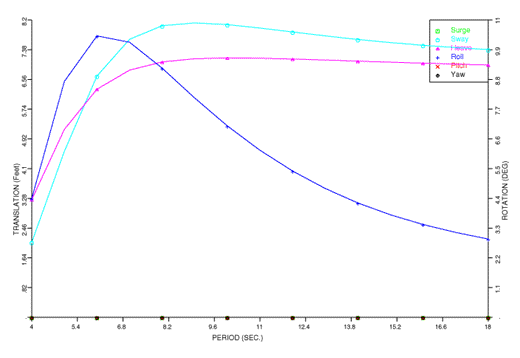
While the motions of the vessel are important, normally one is interested in not the motions themselves, but what they do to the cargo carried by the vessel. From the cargo's perspective moving the vessel does two things:
- It produces an inertia load, and
- It rotates the cargo frame of reference so that gravity appears to act in a different direction.
